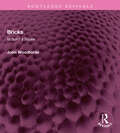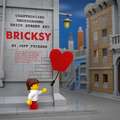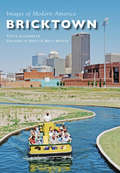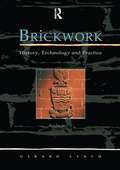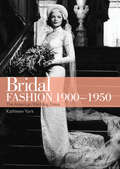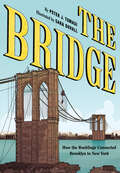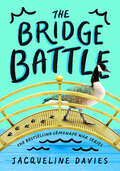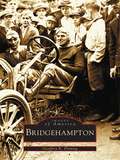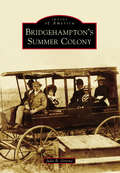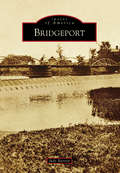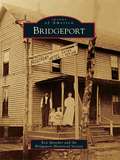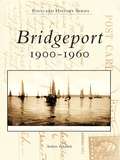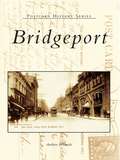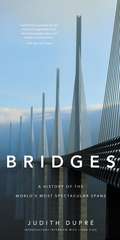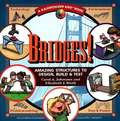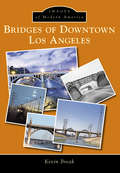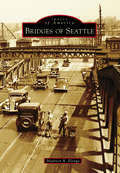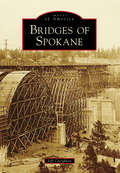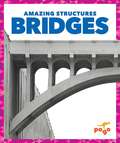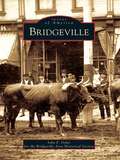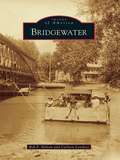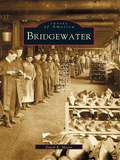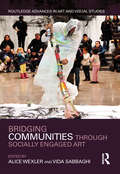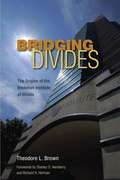- Table View
- List View
Bricks: to build a house (Routledge Revivals)
by John WoodfordeFirst published in 1976, Bricks tells the story of bricks in Britain. The story of the brick begins with the sun-dried, mud bricks formed with hands alone. Walls built with such bricks have been found in the ruins of Jericho – probably the oldest town in the world. John Woodforde describes bricks and brickmaking in the ancient world and in Europe and America; he gives a comprehensive account of brickmaking in Britain up to the 1970s. He describes the properties of bricks, including those of the unique fletton brick, manufactured by the London Brick Company. The author looks, too, at the equipment and techniques used to fashion bricks, the brickmakers themselves and brickwork of many kinds: in garden walls, sewers, canals, railways and roads as well as in Hampton Court and the Nash terraces of Regent’s Park. This book will be of interest to students of architecture, engineering, chemistry and construction.
Bricksy: Unauthorized Underground Brick Street Art
by Jeff FriesenFrom Jeff Friesen, award-winning photographer and author of United States of LEGO®, comes a hilarious new book of diorama photographs that uses LEGO bricks to spoof the famous work of the mysterious anonymous graffiti artist known as Banksy. Friesen gives new meaning to gritty street art using clean, modernist bricks. Bricksy goes beyond transforming the medium by expanding the scenes it plays on and adding a humorous twist to each one. Each of the eighty-four photographs is wittily captioned, delightful to look at, and appropriate for a wide range of ages. At the end of the book is a legend featuring thumbnail reproductions of each original Banksy so readers can test their knowledge of Banksy’s catalogue with Friesen’s LEGO spinoffs. While traditional street art is often rushed along by the threat of local law enforcement, Friesen has bountiful time to reimagine Banksy’s work into glossy LEGO glory that comes off the walls and springs to life. Banksy’s iconic characters gain intriguing new stories. Readers will discover where Banksy’s monkeys are taking charge and who the bouquet thrower’s star-crossed lover is. You’ve never seen Banksy like this before. You’ve never seen LEGO like this before. Bricksy is a must-have book for fans of Banksy, fans of LEGO, and anyone with a sense of humor.
Bricktown (Images of Modern America)
by Steve Lackmeyer Brent Brewer Brett BrewerBricktown, once an area reserved for federal troops, was given to Oklahoma City for development in 1898. Brick warehouses originally were built along rail lines to house wholesale operations, but a half century later, the district was abandoned as industry moved farther away from the urban core. The forgotten warehouse district was rediscovered by Neal Horton, who started the movement of transforming the area in 1979. Jim Brewer carried out Horton's vision, enabling Bricktown to become a regional destination where historic preservation and modern entertainment would merge. Excursion boats traverse a modern man-made recreational canal built in 1999 that flows between century-old brick warehouses. Bricktown's restaurants, shops, and attractions have hosted some of the biggest names in politics and entertainment. The transformation continues with the opening of The Criterion concert hall in 2016 and the construction of more retail space and restaurants, 400 apartments, and several hotels.
Brickwork: v.2
by Gerard C.J. LynchThis series of books offers an in depth guide to all aspects of brickwork and bricklaying practice. Gerard Lynch, author of the guide to "Guaged Brickwork", has put together these comprehensive and instructive volumes, linking past knowledge and practices with modern skills and materials, so that both can be fully examined and understood. At a time when the conservation and restoration of old buildings demand a more sympathetic handling, such a work should be a useful addition to the existing literature, and an essential source of reference for all those involved in the construction and repair of brick buildings. The second of six volumes which offer an in-depth guide to all aspects of brickwork and bricklaying practice, this volume examines the elements of building construction in brick. The text covers both the contemporary and traditional aspects of substructure brickwork. Chapter one studies the setting out of a small building, and then progresses to foundations, examining the historical, as well as current practices, along with information on modern concrete production. The following six chapters cover both the contemporary and traditional aspects of substructure brickwork, basements, sleeper walls, damp proof courses, cavity walling, and jointing and pointing. The volume concludes with useful advice on achieving controlled and efficient bricklaying.
Bridal Fashion 1900-1950
by Kathleen YorkFrom homespun to haute couture, the dresses worn by American brides in the first half of the twentieth century had myriad influences. In Bridal Fashion 1900-1950, living-history expert Kathleen York takes readers on an elegant journey back in time, marking the changes that economics, popular culture, and even politics have made to style over the years. Both brides-to-be looking for inspiration and nostalgia-seekers will enjoy this lavishly illustrated tour of an era that saw the average wedding evolve from a simple affair for a few family members into a dazzling, and often expensive, gala for hundreds of guests.
The Bridge: How the Roeblings Connected Brooklyn to New York
by Peter J. TomasiA graphic novel depicting the history of the construction of the Brooklyn Bridge and the family that made it happen.In this extraordinary graphic novel, author Peter J. Tomasi and illustrator Sara DuVall bring to life the construction of one of the most iconic landmarks in the world and shine a light on the incredible triumphs and tragedies that went into building the Brooklyn Bridge. After the accidental death of John Augustus Roebling in 1869, it was up to Roebling’s son Washington to complete the massive project. Unfortunately, there was more pain to follow, as Washington developed caisson disease, leaving him bedridden. Washington’s wife, Emily, deftly assumed a key role in the bridge’s construction by becoming her husband’s eyes and ears at the work site. As Washington’s wisest council, Emily skillfully navigated work crews who now had to answer to a woman, contractors, a hostile press, and a greedy city politician—all looking to take credit for the magnificent bridge slowly making its way across the East River. Through it all, the Roeblings persisted, rising above every obstacle to build the great bridge that connects Brooklyn and New York. “Told by prolific superhero scribe Tomasi . . . with charmingly understated art by the Eisner-nominated Duvall . . . this historical graphic narrative presents dramatic events in a matter-of-fact, realistic way. . . . Rather than being a story of a singular genius overcoming adversity, the book is a paean to collaboration. Iconic structures often have fascinating stories behind them, but rarely do the tellings emphasize the human as this one does,” —Publishers Weekly“[Tomasi] does a magnificent job of depicting the politics, the danger, and the tenacity of the Roebling family and the hundreds of workers who built the bridge,” —Good Comics for Kids
The Bridge Battle (The Lemonade War Series #6)
by Jacqueline DaviesIn this gripping, funny addition to the bestselling Lemonade War series, both Jessie and her brother Evan find themselves unexpectedly cast as outsiders. How they find their way forward makes for a timeless story about the power of courage and kindness.Evan and Jessie Treski have waged a lemonade war, sought justice in a class trial, unmasked a bell thief, and created a professional magic show. Yet for all their skills and talents, both find themselves being singled out this summer for reasons beyond their control.Natural-born leader Evan, who is always good at making new friends, discovers he is at the mercy of a bully on the summer school playground, and is pressured to act in a way he never has before.Science-loving Jessie just wants to construct the best bridge she can for the competition next month, yet she is stuck in the wrong summer camp, surrounded by kids who believe fairies are more real than physics and a group of girls who tortured her back in second grade. Suddenly, she, too finds herself acting in ways that puzzle her.Bestselling author Jacqueline Davies once again shows how well she understands her readers in this timely story of how being true to ourselves can help us remember how to treat others.
Bridgehampton (Images of America)
by Geoffrey K. FlemingBridgehampton is a fascinating look at one of the prime resort areas on the South Fork of Long Island. The history of Bridgehampton was captured magnificently by studio and itinerant photographers whose work from the mid-1800s to the late 1900s is reflected here. These stunning images show people as they raised children, worked on the farm, worshiped, studied, socialized, and played. The faces show expressions of pride, joy, and, occasionally even boredom, providing a realistic portrayal of the past.
Bridgehampton's Summer Colony (Images of America)
by Julie B. GreeneThe hamlet of Bridgehampton was settled in 1656 and aptly named for the bridge that was built to connect the settlements of Mecox and Sagaponack. Ninety miles from New York City, this rural farming community was transformed by the arrival of the Long Island Rail Road in 1870. With the notion that salt air and sea breezes were the perfect relief from the hot and sweltering isle of Manhattan, wealthy New Yorkers made the sojourn to the pristine shores of the Atlantic Ocean. On a trip down Ocean Road toward the beach, one would pass the grand homes of a toy importer, a pen manufacturer, a coal industrialist, a merchant tailor, and an inventor--the established summer colony. The region quickly gained a reputation as a pleasant summer resort--a reputation that still thrives today.
Bridgeport
by Judy BarrettA truly unique hamlet, Bridgeport lies in both the towns of Cicero, in Onondaga County, and Sullivan, in Madison County. It is divided only by Chittenango Creek, which was the main attraction for settlement in the early years. Farms developed on the shores of Oneida Lake and the creek, while small industries sprang up in the hamlet near the creek rapids and along what later became Route 31. These businesses evolved to support the needs of the area. On the west side of the creek were a sawmill, which provided lumber for homes, and a tannery, which made leather for harnesses, boots, and shoes. On the east side, a blacksmith shop repaired wagons and shoed horses, while a cooper made barrels among other blossoming businesses. When a bridge and dam were built as a power supply, the hamlet was aptly named Bridgeport.
Bridgeport (Images of America)
by Bridgeport Historical Society Ken SprecherIn 1860, John Butterfield rerouted his famous stage line over the west fork of the Trinity River, and soon a small community sprang up along the banks near the new toll bridge. The settlement became known as Bridgeport, and its pioneers found themselves in the middle of both Texas and American history. Since then, Bridgeport's contributions to history have been achieved through the area's land, as well as the rich oil that flowed beneath the rugged, cactus-dotted country. Recognizing the importance of the earth and what lay below took the skill of entrepreneurs and the hard work of many people. The cast of pioneer characters included a young, well-educated New Yorker seeking adventure in the new republic, a stern but generous engineer from Pennsylvania, and a billionaire wildcatter from Houston. Not forgotten are the stories of immigrants from all over the world whose lives have enriched Bridgeport's historic past. Today Bridgeport continues to utilize natural resources while developing its local heritage and ecotourism sites.
Bridgeport: 1900-1960
by Andrew PehanickBridgeport: 1900-1960 presents a fascinating look into the history of Bridgeport through vintage postcards from the city's formative years. These vintage postcards depict the change and expansion in Bridgeport during the 20th century, from the growth of the University of Bridgeport from a small junior college into a major university to the changes in transportation from the horse and buggy to early automobiles and trolley cars. Bridgeport's waterfront played an important role in the development of the city, drawing visitors and wealthy residents who built homes along the shore. Following the two world wars, the city saw a large population increase, and a building boom soon followed. Factories and homes were built, retail stores moved in, and recreational options increased to serve the needs of the thousands of people who came to Bridgeport seeking employment.
Bridgeport: 1900-1960 (Postcard History)
by Andrew PehanickThe golden age of postcards, which took place between 1900 and 1940, was also the golden age of Bridgeport. Local and national publishers printed scenes of the city's beautiful and renowned parks, magnificent mansions, palatial theaters, and sprawling factories, as well as its busy streets and unique architecture. These cards carried images of Bridgeport near and far. Recipients of these mementos could imagine building automobiles at the Locomobile factory, dining at the Amazon Caf©, staying at the Stratfield Hotel, riding the carousel at the Steeplechase Island amusement park, shopping at Howlands, admiring the Wheeler Mansion, attending mass at the South Congregational Church, or watching the activity at the winter quarters of the Ringling Brothers and Barnum & Bailey Circus. Bridgeport takes the modern reader on a journey into the past through nearly two hundred of these vintage postcard images.
Bridges: A History of the World's Most Spectacular Spans
by Judith DupreFrom the best-selling author of Skyscrapers comes the much-anticipated twentieth-anniversary edition of her magnificent chronological tour of the world's most significant and eye-popping spans, now in color and bigger than ever. This visual history of the world''s landmark bridges is updated and expanded since its initial publication twenty years ago, with all-new photographs and features on cutting edge work by international superstars of architecture and engineering. Spanning two-thousand years of technological and aesthetic triumphs, Bridges stands as the most thorough, authoritative, and gorgeous book on the subject. With its dynamic design and oversized format, the book is as dramatic as the structures it celebrates. Breathtaking photographs capture the bridges' details as well as their monumental scale; location maps and architectural drawings invite you behind the scenes as new bridges take shape; and lively commentary on each explores its historical context and significance. Throughout, informative profiles, sidebars, and statistics make BRIDGES an invaluable reference as well as a visual feast. Technological advances, structural daring, and artistic vision have propelled the evolution of bridge designs around the world. The last thirty years has seen the construction of masterpieces such as the Zakim Bridge that changed the city of Boston; Gateshead Millennium Bridge in England, a pedestrian tilt bridge that closes like an eye when it is raised; the Millau Viaduct in Tarn Valley, France, now the tallest cable-stay bridge in world; and the 102-mile Danyang-Kunshan Grand Bridge in China, the longest in the world. This all-new twentieth-anniversary edition features profiles on these amazing spans and on beloved landmarks, such as the Golden Gate and the Brooklyn Bridge, as well as thematic chapters on lighting technologies, military bridges, and bridges in the movies.
Bridges!: Amazing Structures To Design, Build And Test
by Carol A. Johmann Elizabeth J. RiethBuild bridges of your design -- from the 'workhorse' truss-beam bridge to the dazzling suspension bridge. Use bridge-building basics, and, along the way, discover how science and creativity come together in the creation of those weight-bearing wonders -- bridges. Choose the best bridge design for different sites. Make decisions about cost, safety, materials, and the environment. Build and innovate using available materials. Test your construction for function and load.
Bridges and Mediation in Higher Distance Education: Second International Workshop, HELMeTO 2020, Bari, BA, Italy, September 17–18, 2020, Revised Selected Papers (Communications in Computer and Information Science #1344)
by Laura Sara Agrati Daniel Burgos Pietro Ducange Pierpaolo Limone Loredana Perla Pietro Picerno Paolo Raviolo Christian M. StrackeThis book constitutes the thoroughly refereed post-conference proceedings of the Second International Workshop on Higher Education Learning Methodologies and Technologies Online, HELMeTO 2020, held in Bari, Italy, September 2020. Due to the COVID-19 pandemic the conference was held online. The 25 revised full papers and 3 short papers presented were carefully reviewed and selected from a total of 59 submissions. The papers present recent research on challenges of implementing emerging technology solution for online, online learning pedagogical frameworks, facing COVID19 emergency in higher education teaching and learning, online learning technologies in practice, online learning strategies and resources, etc.
Bridges of Downtown Los Angeles
by Kevin BreakThe Los Angeles River was tamed years ago. The river, by nature wanting to be violent and random, doses now in a concrete bed through downtown Los Angeles. In the city's core, there are over a dozen bridges that connect Los Angeles across the river--and these bridges are architectural marvels! These bridges were built in the first decades of the 1900s, and their history continues. The largest and longest bridge, the Sixth Street Viaduct, is in the process of being replaced. Others have been upgraded and enlarged; Spring Street is underway now. Many of the bridges were designed by one man, Merrill Butler, who made each bridge different, yet matching. In this volume, the reader will explore the necessity of the bridges, how they came to be, and where they are going in the future. The time is ripe for a reexamination of these jewels of downtown Los Angeles.
Bridges of Seattle (Images of America)
by Maureen R. ElengaSeattle is situated in a region of outstanding scenic beauty, but the forested hills and numerous bodies of water that characterize the city were formidable obstacles to connecting its communities as it grew out from the historic center. Between 1896 and 1930, the city undertook massive landscape regrades, landfills, and waterway cuts to ease movement by land and water. The completion of these efforts allowed for the construction of Seattle's first permanent steel bridges beginning in 1910. Nine bridges included in this book are listed in the National Register of Historic Places. They include Washington's oldest steel arch bridge, the 1911 Twelfth Avenue South Bridge; the 1913 Ravenna Park Bridge; all four of the Lake Washington Ship Canal bascules, constructed between 1917 and 1924; and the Depression-era Aurora, Cowen Park, and Schmitz Park bridges. Bridges of Seattle explores the history of the spans that are a quintessential part of the Seattle experience.
Bridges of Spokane
by Jeff CreightonSpokane's history begins with the arrival of explorer David Thompson, who established the trading post Spokane House in 1810. From that period forward, the area teemed with Euro-American settlers who often mingled with the Native American population. Spokan Falls, officially incorporated in 1881, and by 1891 known simply as Spokane, became ground zero for the extractive industries of mining and logging and later a vast hub for the railroads. These factors led to the greatest boom in the city's history between the years 1900 and 1915. Spokane's growth came on the heels of an increase in the built environment that included the creation of parks, subdivisions, an expanded downtown business district, and an almost feverish movement to create some of Washington's most beautifully designed bridges. Because of this, Spokane has often been referred to as the "City of Bridges."
Bridges (Pogo: Amazing Structures)
by Rebecca PettifordIn Bridges, early fluent readers will explore different kinds of bridge structures while learning about the science behing the engineering. Vibrant, full-color photos and carefully leveled text will engage young readers as they explore the built world around them. An infographic illustrates parts of a bridge, and an activity offers kids an opportunity to extend discovery. Children can learn more about bridges using our safe search engine that provides relevant, age-appropriate websites. Bridges also features reading tips for teachers and parents, a table of contents, a glossary, and an index. Bridges is part of Jump!'s Amazing Structures series.
Bridgeville (Images of America)
by John F. Oyler Bridgeville Area Historical SocietyBridgeville has a rich historical heritage dating back to Colonial times. In the early 1800s, a small village grew along the meandering Chartiers Creek between two bridges on the Black Horse Trail. The construction of the Chartiers Valley Railroad, the establishment of the Norwood Hotel, and the opening of commercial bituminous coal mines in the region generated a population boom that motivated residents to seek autonomy from Upper St. Clair Township. In 1901, the borough of Bridgeville was incorporated, and the next 50 years saw the community become the social and business center for the four neighboring townships with schools, churches, and a bustling downtown business environment. Bridgeville remains close enough to Pittsburgh to enjoy the cultural advantages of a big city, yet far enough away to retain the feel of a small hometown.
Bridgewater (Images of America)
by Bob F. Holton Carleen LovelessThe story of Bridgewater is one of survival. Since its founding in 1835, this community has endured six major floods, economic crises, and a war that took place on its own soil. Despite the adversity it faced, the town has not only prevailed but has grown into one of the strongest and most progressive towns in Virginia.
Bridgewater
by David R. MooreNot long after the Pilgrims came ashore, Bridgewater became the first inland settlement to branch out from the Plymouth Colony, incorporating in 1656. Its fertile soil and bountiful rivers provided for a rich agricultural community. As the Industrial Revolution forced farmers into factories, Bridgewater experienced rapid social and economic growth and change. Iron, shoe, and paper manufacturing flourished, and the railroad brought European immigrants in search of the American Dream. In Bridgewater, vintage images tell the stories of the Bridgewater Academy, the normal school, the changes in and around the common, the business pursuits of local proprietors, and the spiritual and civic life of Bridgewater residents.
Bridging Communities through Socially Engaged Art (Routledge Advances in Art and Visual Studies)
by Alice Wexler Vida SabbaghiPromoting the expansion of art in society and education, this book highlights the significance of the arts as an instrument of social justice, inclusion, equity, and protection of the environment. Including twenty-seven diverse case studies of socially engaged art practice with groups like the Black Lives Matter movement, the LGBTQ community, and Rikers Island, this book guides art educators toward innovative, transdisciplinary, and diverse methodologies. A valuable resource on creating spaces for change, it addresses the relationships between artists and educators, museums and communities.
Bridging Divides: The Origins of the Beckman Institute at Illinois
by Stanley O. Ikenberry Richard H. Herman Theodore L. BrownBridging Divides offers a first-hand account of the origins of the Beckman Institute for Advanced Science and Technology, an interdisciplinary research institute at the University of Illinois at Urbana-Champaign devoted to leading-edge research in the physical sciences, computation, engineering, biology, behavior, cognition, and neuroscience. The book follows the progress of the Beckman Institute's creation, from the initial conceptualization of a large, multi-disciplinary institute; through proposal formulation; to the architectural design and actual construction of its state-of-the-art building, made possible by the largest gift made to any public university at the time: a $40 million contribution from Illinois alumnus and founder of Beckman Instruments, Inc., Arnold O. Beckman and his wife Mabel M. Beckman. Theodore L. Brown, the founding director of the Beckman Institute, brings an insider's personal perspective on its conception and its early operations. The evolution of a physical facility that matched a developing sense of what multidisciplinary and interdisciplinary research might be was a vital ingredient in the Institute's development. In addition, because the Institute represented a dramatic departure from traditional university organization, many challenges involving its administration and faculty had to be overcome. A celebration of the Beckman Institute's first twenty years of operation since the building's completion in 1989, Bridging Divides provides an informative look back at the history of this groundbreaking interdisciplinary research center. The book also includes forewords by Stanley O. Ikenberry, former president of the University of Illinois, and Richard H. Herman, chancellor of the University of Illinois at Urbana-Champaign.
